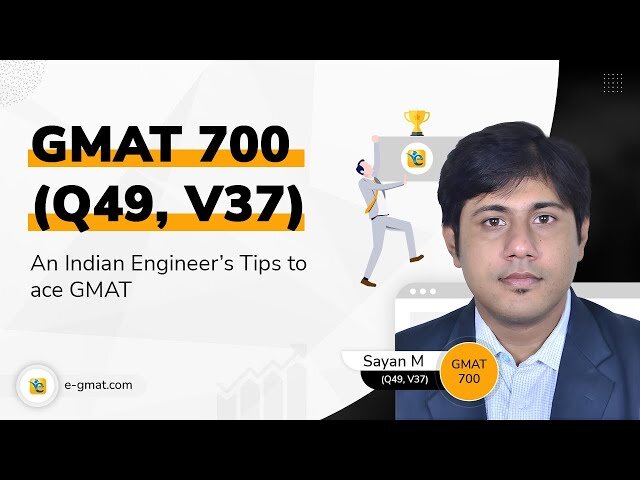“Every mountain top is within reach if you just keep climbing.”
Non-Native English speaker Sayan found himself at the bottom of the mountain when he started preparing for the GMAT.
In his journey to GMAT 700(Q49, V37), he went from being completely unfamiliar with most of the verbal concepts tested in GMAT to being confident in applying complex methods on the actual test day.
An engineering graduate, Sayan was confident of his quant abilities until he faced the GMAT-level questions. He felt pushed his limits as he struggled to conquer his weaknesses in both quant and verbal sections.
After a few initial misses, he began following the e-GMAT course diligently. His determination and persistence while learning new and complex methods eventually began to show results. He re-evaluated his own strategies, identified his mistakes, and continued fixing them until he felt ready to face the GMAT test.
Watch Sayan, a full-time working professional with nine years of academic gap, share his experience of triumphing over weaknesses to ace the GMAT with an 88th percentile score.
GMAT prep plans and initial struggles
Payal: Congratulations Sayan, for your 700(Q49, V37). It must feel good; you got done with GMAT finally.
Sayan: Yes. One part of the process is over. Earlier I thought GMAT was the only hurdle, but now I realize it’s only a part of the journey. There is a long way before I get admission to my preferred B-school.
Payal: It’s good that you focused first on just one part of the hurdle before moving on to the second part. Solving one thing at a time is the right approach.
Sayan: I agree. I only did preliminary research before starting my GMAT prep.
Payal: How many years of experience do you have?
Sayan: I have almost nine years of total work experience. First six years, I worked in direct Sales and Marketing. For the last three years, I have been in a management role.
Payal: Are you looking for an executive or full-time MBA program?
Sayan: I am looking for a full-time executive MBA program. In Indian b-schools, an executive MBA is a one-year full-time course.
Payal: So, you are in full swing of preparing for applications now. Good luck with that. Let’s talk about your GMAT journey. Before enrolling with e-GMAT, how did you prepare for the GMAT exam?
Sayan: The thought of appearing for the GMAT came to me last year around July, but I was not focused then. I just bought the Official Guide and just started looking into resources online. I was not consistent with my preparation. I had been entirely out of touch with academics for the last nine years. It took me time to bring discipline and schedule to my studies. I struggled to have focus or structure while preparing independently for 2-3 months.
That’s when I decided to take external help and subscribe to a course that could help me get into a study regime along with the course content.
Payal: That was very smart. You first tried it on your own, and as soon as you realized it was not working, you took external help. That realization in time is essential.
Sayan: With a full-time working schedule, it would have been difficult for me to go for a classroom program to prepare for GMAT, and that’s why I decided to go for an online course.
On the internet, e-GMAT came across as a well-reputed GMAT prep company. It was the most preferred choice of thousands of GMAT aspirants. That’s why I decided to go for the e-GMAT course. It has turned out to be a good decision for me.
I initially took the three months subscription, but even after subscribing to the course, I was irregular and unable to focus on it. Since COVID was over, I had to relocate to my office location, which also impacted my GMAT preparation. I could not continue my studies for two and a half months until February. That’s when my e-GMAT journey truly started.
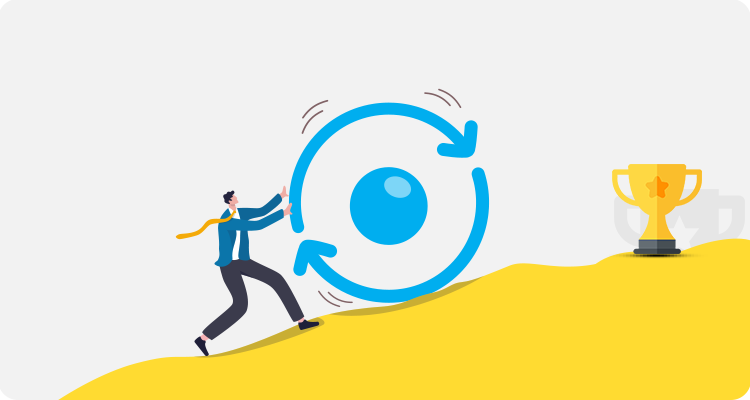
The e-GMAT course has a structure, and I decided to follow it. However, I made a mistake and did not take the diagnostic tests before beginning each section.
Since I was starting after a long gap, I thought it’d be demotivating if I scored low on those diagnostic tests. So, I studied from external sources before going for the diagnostic test. I ended up spending extra time. I’d not recommend anyone following my approach.
Watch this video to learn about P.A.C.E The next generation of Personalized Learning for GMAT Aspirants
Sayan’s GMAT Quant and Verbal Prep with Scholaranium
Payal: You started with verbal SC and CR and completed quant too. You did almost 1400+ questions in both verbal and quant Scholaranium. Tell me, what was your approach toward preparing for these sections?
Sayan: From the start, I struggled a lot with verbal. My comfort level for SC, CR, and RC varied, but overall, I was slow at making improvements. I began by covering all the course content. There are various methods e-GMAT focuses on, such as meaning-based approach and pre-thinking, that helped me a lot.
I come from an engineering background. I initially thought quant would come easy to me. I did not focus on quant as much as I did on verbal.
I struggled again, perhaps because of the 9-year academic gap. I realized that knowing concepts is very different from solving questions based on them in a time-bound environment.
For quant, I did not even do the Official Guide. I followed the e-GMAT quant course entirely along with the Scholaranium.
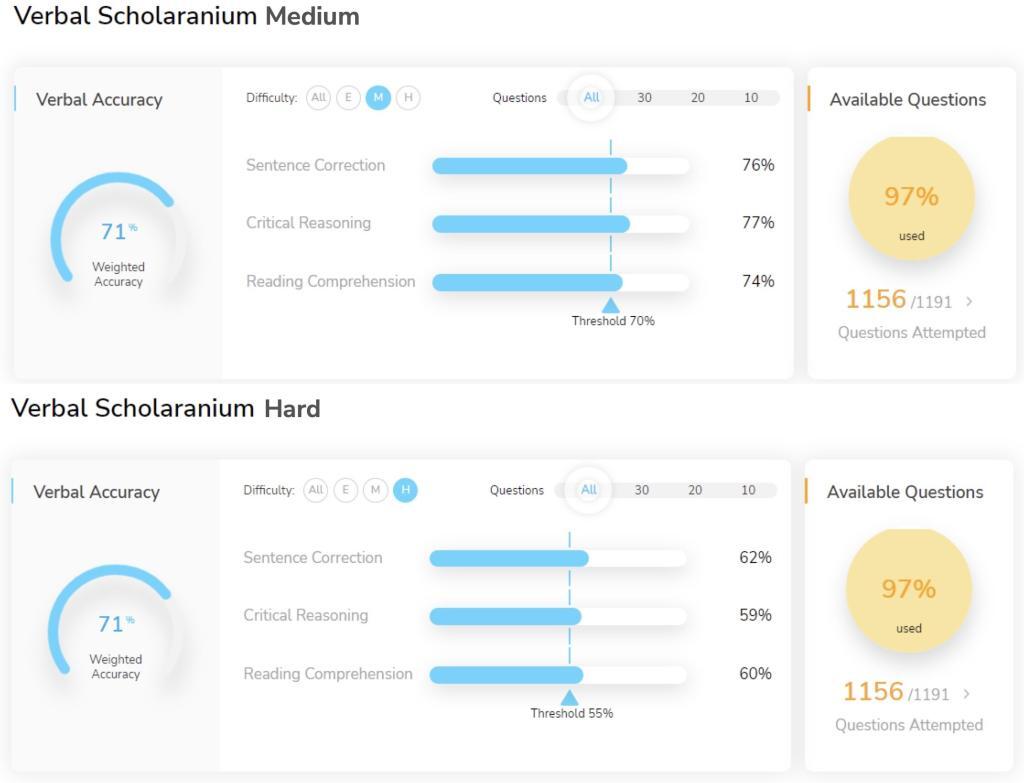
Question Banks & Shortcuts Vs. e-GMAT course
Payal: You said you already knew concepts in quant but struggled to perform in a timed environment. How did the e-GMAT course help you with that?
Sayan: Even if you know the concepts, practicing them is very important, especially while preparing for a test like GMAT. Practicing on the e-GMAT platform made me think quickly and apply the concepts I had learned faster.
Another important thing is that the course covers all possible types of questions that one could expect in the actual GMAT test. Practicing with those exhaustive sets of questions gave me the confidence to take the GMAT test.
Another important thing is that the course covers all possible types of questions that one could expect in the actual GMAT test. Practicing with those exhaustive sets of questions gave me the confidence to take the GMAT test.
I had studied certain topics such as Number Properties in school but faltered at the application stage. Going through the course and practicing with questions helped me build my abilities in those topics.
The solution videos were also very useful in understanding the thought process behind any correct answer. Going through those videos helped me identify my mistakes and learn from them. It also helped me build a logical framework to approach questions.
Payal: You mentioned that the course covers a variety of questions from the GMAT. What difference would it make if you only had these different varieties of questions but not the solutions? Because you can also get a similar variety of questions from the official guide and official practice. What value did the solutions play while going through the course?
Sayan: If you only have questions, there is no structure or learning process to follow. For someone like me who’d not been in practice for so long, random questions would not help build the required skills or confidence. With the e-GMAT course, you can develop your expertise in one topic before moving to another in a structured fashion.
Apart from the solutions, the structure was the most critical factor that helped me improve.
There could be multiple ways to solve any question, and your approach may not be the most time efficient. But for GMAT, it’s essential to focus on solving questions using the most optimum method rather than just solving them. More than the tricks and shortcuts, this test demands understanding the processes at the fundamental level. The solutions available in the course cover these aspects comprehensively. It doesn’t recommend shortcuts, unlike many available online portals. During the GMAT exam, shortcuts don’t come to mind. The solutions are focused on building a logical framework.
There could be multiple ways to solve any question, and your approach may not be the most time efficient. But for GMAT, it’s essential to focus on solving questions using the most optimum method rather than just solving them. More than the tricks and shortcuts, this test demands understanding the processes at the fundamental level. The solutions available in the course cover these aspects comprehensively. It doesn’t recommend shortcuts, unlike many available online portals. During the GMAT exam, shortcuts don’t come to mind. The solutions are focused on building a logical framework.
Payal: Absolutely. When we launched our quant course, many people asked us for shortcuts. It’s not something a course should teach. The course focuses on teaching the concepts and how to approach various types of questions. Once you’ve developed the logical thought process, you should be able to come up with your own shortcuts. That’s how a course should work, and that’s what we try to achieve.
Sayan: Yes. You can apply shortcuts only to easy-level or familiar questions. For hard-level and unfamiliar questions, it would not help. Especially during the exam, when the clock is ticking, shortcuts don’t come to your mind. You require a logical framework for that.
Payal: Very well said. With shortcuts, you try to fit the question at hand for the specific patterns you have set your shortcuts for, and that’s how you waste your valuable time.
Importance of timed prep for GMAT
Payal: How did practicing with Scholaranium help you?
Sayan: The versatility and number of questions Schaolaranium provided helped me greatly. However, I made one mistake there, also. When I started using it, I did not time-bind myself for the questions until the last one and a half months. To make the most benefit of Scholaranium, you must also follow the timing. If you prepare with the questions in a timed manner, you’d be ready to face the GMAT test confidently.
Read this article to learn all about e-GMAT’s Scholaranium: The Most Advanced Quizzing Platform in the World!
Payal: In the first stage of learning with e-GMAT, don’t time yourself, but as soon as you reach cementing stage, you must start with a timed test. We also have two formats for timing questions, relaxed and standard.
I noticed that you didn’t utilize cementing quizzes at all.
Sayan: That was my biggest mistake, and I realized that quite late.
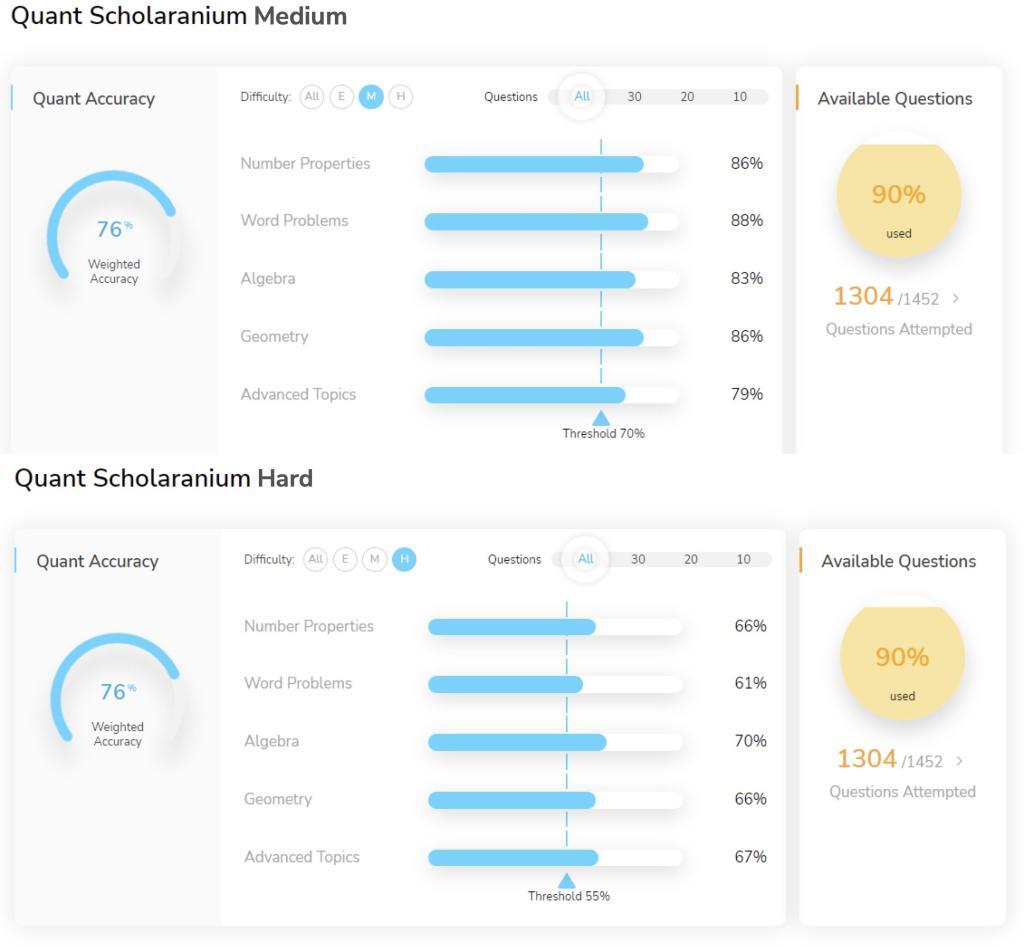
Payal: That’s okay. There could be multiple ways of preparing for the test. The one we prescribe is there in the course, but the course content is available. Even if you have your own strategy and approach, and you can enjoy the journey to make the most out of it, the purpose is solved. You scored a Q49 which is excellent.
Non-Native’s experience with the e-GMAT verbal course
Payal: How did the verbal course make a difference to you?
Sayan: I started with little confidence. Like most Indian students, I was also struggling with verbal. Even during my early academic years, I was never good at the English Language.
I am glad I’ve been able to break that trend with my score on GMAT. Especially the SC, and methods like modifiers and parallelism were completely alien. I was relatively comfortable with CR because it’s logical. After going through the e-GMAT course, I realized that even SC is mostly about logic. When I started, I had no clue about the logical aspect of Sentence Correction.
In SC, I’d give full credit to the e-GMAT course for the knowledge and score I have gained. Because of the framework and content, I have developed the skills and ability to approach even SC questions logically. The thought process I developed was a phenomenal value add from e-GMAT.
After going through the e-GMAT course, I realized that SC is mostly about logic. When I started, I had no clue about the logical aspect of Sentence Correction. I’d give full credit to the e-GMAT course for the knowledge and score I have gained. Because of the framework and content, I have developed the skills and ability to approach SC questions logically. The thought process I developed was a phenomenal value add from e-GMAT.
Payal: I am so glad that you could look at SC questions through the lens of grammar and logic.
Sayan: In the last 2-3 months, I was entirely approaching SC from a logical perspective, given the modifiers and parallelism.
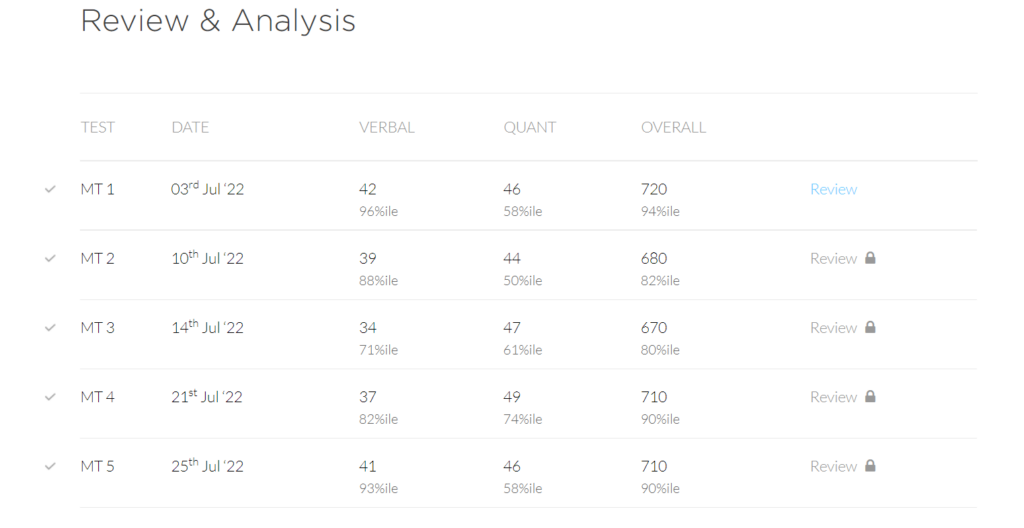
Read this article to learn about strategies, action plans and methods to prepare for GMAT verbal
Payal: How was your RC?
Sayan: I had a hard time with RC as well. I have not been into reading much all my life. And GMAT RC passages are of much more complex structure. I started by following the e-GMAT flow. I’d read and understand the complete passage before going to the questions. I had doubts initially if that was the right approach for me as I’d take 9-10 minutes just to read the passage. I continued with it anyway and tried to build my skills.
Payal: I’d like to commend you here. Your seriousness and maturity of your years of experience are visible from how you handled your prep journey. You could not get there but did not second guess the process.
Sayan: To be honest, I thought about the alternate way and even tried a couple of times, but quickly I realized that the right way and ill have to build my experience following this approach only. Going back and forth with different learning methods will only waste my time.
Three tips for GMAT aspirants
Payal: If you were to recommend three points to other GMAT aspirants, what would those be?
Sayan: Consistency is crucial. You must invest focused time regularly, even if it’s just 1-2 hours per your schedule. It’s not possible to succeed if you just study over the weekends.
Secondly, strengthen your concepts before practicing questions.
Third, try to practice in a time-bound manner. That’s the best way to go about it as early as possible.
Payal: Thank you for your time. Good luck with the next step in the process.


